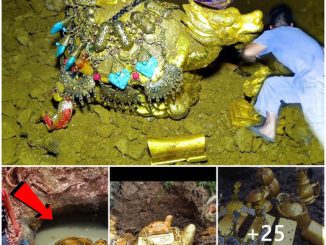
A cache of gold coins found buried on farmland in the United Kingdom has caught the attention of coin experts, who have linked the treasure trove to the Roman Empire.

One of the gold coins from the Roman empire was found in the English countryside. Augustus Caesar is featured on the front, and his grandson Gaius on horseback is depicted on the back.
So far, metal detectorists have discovered 11 coins on a remote stretch of cultivated field located in Norfolk, a rural county near England’s eastern coast, and experts remain hopeful that more could be unearthed in the future.
Damon and Denise Pye, a pair of local metal detectorists, found the first of several gold coins in 2017 after local farmers finished plowing the soil at the end of the harvest season, which made the land prime for exploration. The haul has been dubbed “The Broads Hoard” by local numismatists (coin specialists and collectors), for its geographic location near The Broads, a network of rivers and lakes that run through the English countryside.
“The coins were found scattered around in the plow soil, which has been churned up year after year, causing the soil to be turned over constantly and led to them eventually coming to the surface,” said Adrian Marsden, a numismatist at Norfolk County Council who specializes in ancient Roman coins.
“The first year, [the Pyes] found four coins, and the following year one more, and then they found a few more the year after that. They’ve said to me that they think they found the last one, and I always say, ‘I bet not.’ They’re slowly coming to the surface; I think there’s more.”
Marsden dated the “exceptional” bounty of gold coins to sometime between the first century B.C. and the first century A.D. Interestingly, all of the coins were minted before the Roman conquest, when Britain became occupied by Roman forces starting in A.D. 43 after an invasion launched by Rome’s fourth emperor, Claudius.
Which raises the question: How did the coins end up in a field years before the arrival of Roman forces? While Marsden said that there’s no way of knowing for sure, he thinks there could be a couple of logical explanations for the stockpile of riches.
“It’s apparent that [the coins] went into the ground before the invasion,” Marsden told Live Science. “It’s possible that they could’ve been part of some type of offering to the gods, but more likely someone buried them with the intention of recovering them later. Gold was often used as trade, so it’s possible that a local tribe could’ve gotten ahold of the coins and perhaps planned to use them for other things, such as melting them down to make jewellery.”

The fronts and backs of six of the 11 gold coins from the Roman Empire were found in the English countryside.
The farmland where the coins were found sits on land once occupied by the Iceni, a tribe of British Celts. During the Roman invasion, the tribe’s leader, Queen Boudica, led a revolt against Roman forces, attempting to drive them off their land in A.D. 60. However, despite their initial success, the queen’s army was no match for the Romans, who ultimately won the fight in what is known as the Battle of Watling Street.
The defeat led the queen to kill herself, according to the ancient Roman historian Publius Cornelius Tacitus. However, another ancient Roman historian, Cassius Dio, reported that Boudica died of illness.
In an article written by Marsden and published in a recent issue of The Searcher, a metal detectorist publication, he described there being two types of gold coins in the stash: one type was marked with the portrait of Augustus Caesar, the first emperor of Rome, with Gaius and Lucius, his grandsons and heirs to the throne, on the back of the coin. (However, both grandsons died before they could don the purple and become emperor.) The other also featured Augustus in profile on one side, but with Gaius on horseback on the reverse.
“In the second half of Augustus’ reign, when his position was consolidated, the types [of coins] with dynastic reference increased as an indication of his succession, as is the case here with the extensive coinage for his grandsons, Gaius and Lucius Caesar,” Marjanko Pilekić, a numismatist and research assistant at the Coin Cabinet of the Schloss Friedenstein Gotha Foundation in Germany, who wasn’t involved with the new findings, told Live Science. “They are depicted as the chosen successors of Augustus on the coins, which is indicated by the inscription PRINC(ipes) IVVENT(utes): ‘the first among the young.’”
Each of the coins also features a small indentation at the top, likely indicating that someone tested the coins for their purity, perhaps after they had been minted. Otherwise, “they’re high quality, 20-karat gold,” Marsden said. “If they had been churned around in the soil a lot, I would expect for them to be more scuffed up, but these are not.” Pilekić added that cutting “knicks” into the faces of gold coins was common practice in the Roman Empire, where forgeries were abundant.
“[Some can be seen] even on the portrait of Augustus,” Pilekić said. “This made it possible to check whether the coin was really a gold coin and not a gilded bronze coin, for example. The distrust must have been great, which could indicate many forgeries in circulation.”
In addition to the newfound gold coins, over the years metal detectorists have discovered a treasure trove of Roman possessions in the region, including 100 copper alloy coins, two denarii (Roman silver coins), brooches and more. According to Marsden’s estimate, the gold coins together are valued at approximately $20,000 pounds ($25,000 USD). The British Museum recently acquired the coins as part of its permanent collection.
The findings were published in the May issue of the magazine The Searcher.
“[Some can be seen] even on the portrait of Augustus,” Pilekić said. “This made it possible to check whether the coin was really a gold coin and not a gilded bronze coin, for example. The distrust must have been great, which could indicate many forgeries in circulation.”
In addition to the newfound gold coins, over the years metal detectorists have discovered a treasure trove of Roman possessions in the region, including 100 copper alloy coins, two denarii (Roman silver coins), brooches and more. According to Marsden’s estimate, the gold coins together are valued at approximately $20,000 pounds ($25,000 USD). The British Museum recently acquired the coins as part of its permanent collection.


